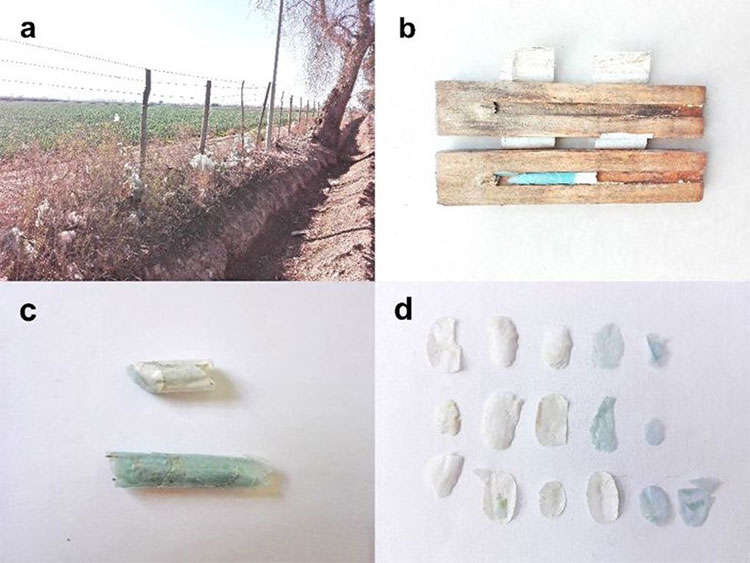Natural bees build nests from ... plastic waste
In Argentina's crop fields, it was discovered that wild bees used exotic materials, instead of wax, to build nests: plastic waste.
Plenty of plastic waste in the form of packaging often appears on farms or is 'intentionally intentionally' discharged at scenic spots or tourist sites. The environment is changing and wildlife must adapt to this. But whether or not they adapt quickly enough to keep up with human impact is still a matter of further discussion.
Researchers from the Argentine National Institute of Agricultural Technology discovered 'plastic' beehives while studying chicory pollination.
Accordingly, the team set up 63 traps around the crop fields. They are like "bee hotels" that people often build in the backyard to keep bees, with long, hollow tubes like honeycomb holes where bee larvae grow.

Plastic materials used by bees to build nests.
Bees can stack these chambers with materials they search for such as mud, leaves, stones, petals and sap. They use these materials to build a cozy nest, split into hamlets along the length, each containing a bee larva.
In the spring and summer of 2017 and 2018, each month, the research team checks the trap team to look for signs of bee activity. There, only 3 groups have bees . to stay. Two of them were built with mud and petals, and there were five healthy adult bees that appeared in these traps. The third nest has three nesting holes made entirely of plastic, carefully cut into oblong and oval shapes and arranged in a overlapping fashion. The first two nest holes are made of thin plastic, light green, like plastic bags at a supermarket. The third hole is made of thicker white plastic.
The researchers said that among the three holes, one of the larvae died, the next one seemed to have left the nest, while the other hole had bee larvae in the process of being released. development. So, among the two nest holes, one larva is dead and the other is mature - suggesting that plastic may not be the best option to build a nest, but it is not bad anyway.
The team was unable to identify the bees that built the nest on these traps, but they believed that this could be the Alfalfa mowing bee (scientific name Megachile rotundata) , a species from Europe that the group studied. Research has shown in the study area that the living environment is quite similar to this area.
Alfalfa bees often cut leaves as well as trim pieces of plastic combined to build nest holes. And in North America, scientists have noted that this particular bee uses plastic to build nest holes.
What makes this new nest different is that all nest holes are made of plastic; And this is the first case of using two different plastics to build a nest.
That's an interesting thing because that means that bees with great flexibility and adaptability will help them keep up with the changes of the environment quickly, especially when people use drugs. Herbicides in areas can reduce the amount of plants that bees normally use to build nests.
Or, maybe because bees in this case only use plastic but not leaves for another reason - maybe they adapt to plastic in some way that we still don't know, such as some. birds use cigarette butts to ward off parasites.
This clearly shows the adaptability of bees in finding alternative materials to build the nest in the confusion of the environment in which humans are the main agents.
- How long does it take for plastic waste to decompose?
- The shocking images of the consequences of plastic waste, environmental pollution with the natural world
- Vietnam is the top 5 countries that discharge most plastic waste into the sea
- Turning plastic into petroleum: 2-in-1 solution for plastic waste
- What happens to a plastic bottle after being thrown into the trash?
- The danger of the ocean
- Deep rice eat plastic - solution to minimize landfill burial?
- Tragedy: Whales are eating hundreds and thousands of plastic trash every day
- For the first time Vietnam built roads from plastic waste
- Producing bricks from ... plastic waste
- Alarm plastic trash appears in the fry
- The end of the era of plastic garbage is probably coming soon, thanks to this invention
 'Fine laughs' - Scary and painful torture in ancient times
'Fine laughs' - Scary and painful torture in ancient times The sequence of numbers 142857 of the Egyptian pyramids is known as the strangest number in the world - Why?
The sequence of numbers 142857 of the Egyptian pyramids is known as the strangest number in the world - Why? Miracle behind the world's largest stone Buddha statue
Miracle behind the world's largest stone Buddha statue What is alum?
What is alum?